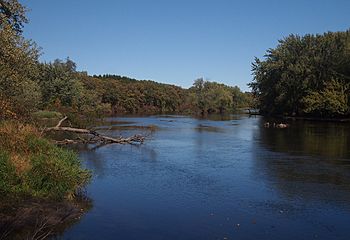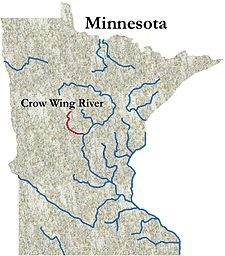Crow Wing River facts for kids
Quick facts for kids Crow Wing River |
|
|---|---|

The Crow Wing River in Old Wadena County Park
|
|

The Crow Wing River
|
|
| Country | United States |
| State | Minnesota |
| Physical characteristics | |
| Main source | 1,391 ft (424 m) 47°00′07″N 94°44′29″W / 47.00194°N 94.74139°W |
| River mouth | 1,145 ft (349 m) 46°16′16″N 94°20′23″W / 46.27111°N 94.33972°W |
The Crow Wing River is a 113-mile-long (182 km) river in Minnesota, United States. It flows into the Mississippi River. The river starts from a group of 11 lakes in Hubbard County, Minnesota. It then flows south and east, joining the Mississippi River near Crow Wing State Park.
The river's name comes from the Ojibwe language. Gaagaagiwigwani-ziibi means "Raven-feather River." There is a special island shaped like a wing at the river's mouth. This island is why the river got its unique name. Many people enjoy canoeing on the Crow Wing River. It is known as a great "wilderness" route because of its many campsites. The river is usually shallow, about 3 feet (0.91 m) deep, but it is deep enough for canoeing.
Contents
Exploring the Crow Wing River Landscape
Much of the Crow Wing River is surrounded by thick forests. When the river first starts, it flows through low, wet areas called marshes. As it moves south, the river gets wider. The banks along its sides also become taller.
Forests and Plants Along the River
The sandy plains of northern Wadena County, Minnesota once had huge white and red pine forests. Now, Jack pine trees have mostly taken their place. The ground is covered with many plants. You can find hazel, blueberries, and sweet fern. There are also bearberry, wintergreen, and bracken. Even reindeer moss grows here.
Further down the river, you will find a different kind of forest. This "river bottom forest" has many types of trees. These include elm, ash, and cottonwood. You can also see box elder, oak, and basswood. Maple, willow, and aspen trees are common too. Scattered throughout the river area are grasslands, bogs, and swamps.
Animals and Fish of the Crow Wing River
The Crow Wing River has a sandy bottom. It does not have many deep spots or places for fish to hide. Because of this, it is not a great river for catching popular game fish. The most common fish here are Shorthead Redhorse and White Sucker. These are known as "rough fish."
Wildlife You Might See
The many different plants along the river help support lots of wildlife. If you are canoeing, you might spot various animals. Look for turtles, otters, and muskrats. Beavers, mink, and raccoons also live here. You might also see gophers, chipmunks, squirrels, and rabbits.
Sometimes, bobcats and a few black bears are seen in the river area. It is also common to see eagles flying overhead. They often fish from the river. Other game animals include white-tailed deer, ruffed grouse, and woodcock. You might also see different types of waterfowl (ducks and geese). However, the river does not have many waterfowl. This is because there are not many water plants or quiet backwater areas for them.
History and People of the Crow Wing River
The Dakota Indians lived in the Crow Wing region for a long time. Then, in the early 1700s, the Ojibwe people started moving west into the area. By the early 1800s, the Ojibwe controlled the lands west of the Mississippi River. They also controlled the lands north of the Crow Wing River.
Ancient Sites and Early Trade
You can still find signs of Native American history along the river. There are Native American burial mounds at several spots. One important site is at river mile 61.
Fur traders came to this region in the early 1700s. In 1792, the North West Company built the Wadena Trading Post. This post was on the west side of the river. It was located where the Crow Wing River meets the Partridge River. By the 1800s, there was a lot of trade happening on land. The Old Otter Tail Trail crossed the river near the Wadena post. This trail was a main route between St. Paul and Fort Garry in Winnipeg.
Lumber and Modern Uses
The town of Nimrod, Minnesota became an important lumbering center. This was from the 1870s to the early 1900s. The dense forests near the river provided lots of timber. By the early 20th century, most of the old forests were cut down. After that, the area's economy changed to focus on farming.
Today, the Crow Wing River still attracts visitors. Many outdoor lovers come in the late spring. Native Americans also visit in the autumn. They come to harvest wild rice that grows along the river.

